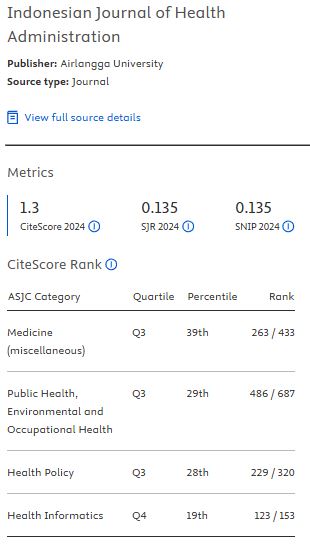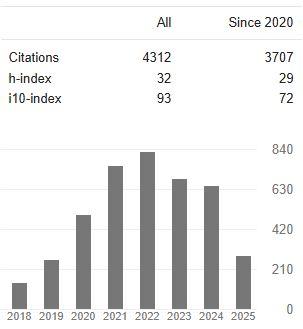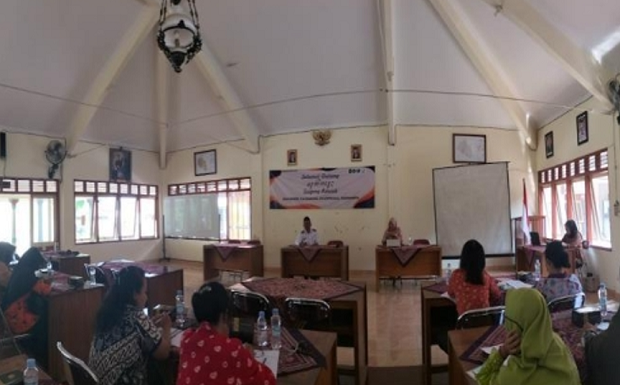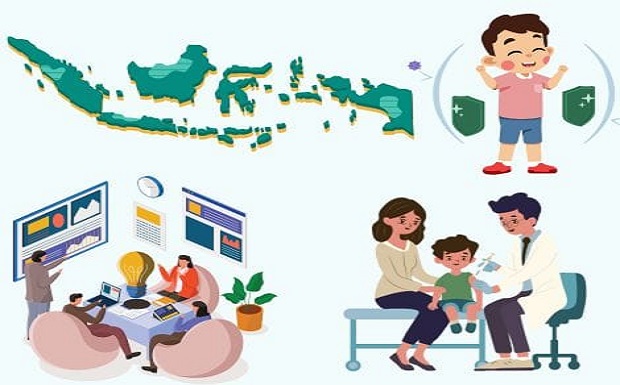Literasi Informasi Kesehatan Nifas Ibu Hamil Berstatus Sosial Menengah ke Bawah
Downloads
Background: Post-partum health information is hardly accessible to pregnant women. In fact, post-partum health literacy for pregnant mothers in relation to socio-economic factors allows the decline of post-partum morbidities.
Aim: This research aimed to analyse the post-partum health information literacy of pregnant women with middlelow social status.
Method: This was a quantitative study by using a direct survey technique to assess respondents' information literacy about post-partum health. There were 79 pregnant women to take part in this study. They only completed their high school degree as their highest educational level, and their family income was less than Rp 2,000,000
($180) per month. This indicated that these participants are coming from middle-low social status. A selfdeveloped questionnaire was used in this study to be filled by respondents.
Results: Results showed that nearly half of respondents (44.1%) found post-partum health information for their self-hygiene well-being after baby delivery process finished. Information accessed by pregnant women were elaborated from other people (66.1%) like as parents, relatives, colleagues, or health officers. Most of the participants agreed to trust captured information (78%), but there were only little use the information (11.9%).
Conclusion: To summarize, the health information literacy of pregnant mothers with middle-low status was tenuously elaborated from other people, and most of them believed it. It is possible that information obtained from other people is incorrect, so pregnant mothers might use wrong information.
Keywords: health, information literacy, post-partum, pregnant women
Anders Haug, Frederik Zachariassen, D. van L. (2011) ‘The Costs of Poor Data Quality', Journal of Industrial Engineering and Management, 4(2), pp. 168–193. doi: 10.3926/jiem.2011.v4n2.p168-193.
Cheng, C.-Y., Fowles, E. R. and Walker, L. O. (2006) ‘Postpartum Maternal Health Care in the United States: A Critical Review', Journal of Perinatal Education, 15(3), pp. 34–42. doi: 10.1624/105812406X119002.
De Choudhury, M., Morris, M. R. and White, R. W. (2014) ‘Seeking and Sharing Health Information Online', in Systems, C. '14 P. of the S. C. on H. F. in C. (ed.) Proceedings of the 32nd annual ACM conference on Human factors in computing systems - CHI '14. New York: CHI, pp. 1365–1376. doi: 10.1145/2556288.2557214.
Dalberg (2012) Women and the Web, Intel Corporation. United States: Intel Corporation. Available at: https://www.intel.com/content/dam/www/public/us/en/documents/pdf/women-and-the-web.pdf (Accessed: 7 January 2018).
Ekawati and Haniah (2017) ‘Pengetahuan Ibu Nifas Tentang Kunjungan Ulang Masa Nifas di Puskesmas Tepus 1 Kabupaten Gunungkidul', Jurnal Media Ilmu Kesehatan, 6(1), pp. 26–31. doi: https://doi.org/10.30989/mik.v6i1.208.
Kementerian Kesehatan Republik Indonesia (2016) Buku Kesehatan Ibu dan Anak. Jakarta: Kementerian Kesehatan Republik Indonesia. Available at: http://www.depkes.go.id/article/view/16091500001/Buku-Kesehatan-Ibu-dan-Anak-Tahun-2016.html.
Khafidzoh, A., Rahfiludin, M. Z. and Kartasurya, M. me. (2016) ‘Hubungan Keikutsertaan Kelas Ibu Hamil dengan Perilaku Ibu dalam Perawatan Masa Nifas (Studi di Puskesmas Cepiring Kabupaten Kendal)', Jurnal Kesehatan Masyarakat (e-journal), 4(3), pp. 147–157. Available at: https://media.neliti.com/media/publications/18602-ID-hubungan-keikutsertaan-kelas-ibu-hamil-dengan-perilaku-ibu-dalam-perawatan-masa.pdf.
Missiriya, S. (2016) ‘Knowledge and Practice of Postnatal Mothers Regarding Personal Hygiene and Newborn Care', International Journal of Pharmaceutical Sciences, 40(1), pp. 89–93. doi: 10.22038/IJN.2013.692.
Mokhtar, me. A., Majid, S. and Foo, S. (2004) ‘Measuring Information Literacy In Education', in Information, Learning, Innovation: Delivering Global Knowledge. Brunei: NTU, pp. 1–18. Available at: http://www.ntu.edu.sg/home/sfoo/publications/2004/2004CILLLI_fmt.pdf.
Nan Xiao, Raj Sharman, H. R. Rao, S. U. (2014) ‘Factors Influencing Online Health Information Search: an Empirical Analysis of a National Cancer-Related Survey', Decision Support System, 57, pp. 417–427. doi: 10.1016/j.dss.2012.10.047.
Nighat Sultana, B. T. (2015) ‘Low Utilization of Postnatal Care: Searching The Window of Opportunity to Save Mothers and Newborns Lives in Islamabad Capital Territory, Pakistan', BMC Research Notes. BioMed Central, 8(1), pp. 1–5. doi: 10.1186/s13104-015-1646-2.
Nymisha Chilukuri, Meredith West, Janice Lynn Henderson, Shari Lawson, Robert Ehsanipoor, Kathleen Costigan, Sarah Polk, W. B. (2015) ‘Information and Communication Technology Use Among Low-Income Pregnant and Postpartum Women by Race and Ethnicity: A Cross-Sectional Study', Journal of Medical Internet Research, 17(7), pp. 1–20. doi: 10.2196/jmir.3916.
Sulaeman, E. S., Murti, B. and Waryana, W. (2015) ‘Peran Kepemimpinan, Modal Sosial, Akses Informasi serta Petugas dan Fasilitator Kesehatan dalam Pemberdayaan Masyarakat Bidang Kesehatan', Jurnal Kesehatan Masyarakat Nasional, 9(4), pp. 353–361. doi: 10.21109/kesmas.v9i4.749.
Tara Shah, S. P. (2016) ‘Knowledge and Practice Regarding Postnatal Care among Mothers Residing In Selected Slum Area of Dharan, Nepal', International Journal of Health and Medicine, 1(1), pp. 1–4.
Y.P Rahayu, Sarkiah, N. D. U. (2016) ‘Hubungan Motivasi Ibu dan Dukungan Keluarga dengan Kunjungan Nifas Lengkap di Wilayah Kerja Puskesmas Beruntung Raya Kota Banjarmasin', Jurnal Dinamika Kesehatan, 7(2), pp. 266–278. doi: 10.1007/s40304-015-0072-z.
1. As an author you (or your employer or institution) may do the following:
- make copies (print or electronic) of the article for your own personal use, including for your own classroom teaching use;
- make copies and distribute such copies (including through e-mail) of the article to research colleagues, for the personal use by such colleagues (but not commercially or systematically, e.g. via an e-mail list or list server);
- present the article at a meeting or conference and to distribute copies of the article to the delegates attending such meeting;
- for your employer, if the article is a ‘work for hire', made within the scope of your employment, your employer may use all or part of the information in the article for other intra-company use (e.g. training);
- retain patent and trademark rights and rights to any process, procedure, or article of manufacture described in the article;
- include the article in full or in part in a thesis or dissertation (provided that this is not to be published commercially);
- use the article or any part thereof in a printed compilation of your works, such as collected writings or lecture notes (subsequent to publication of the article in the journal); and prepare other derivative works, to extend the article into book-length form, or to otherwise re-use portions or excerpts in other works, with full acknowledgement of its original publication in the journal;
- may reproduce or authorize others to reproduce the article, material extracted from the article, or derivative works for the author's personal use or for company use, provided that the source and the copyright notice are indicated.
All copies, print or electronic, or other use of the paper or article must include the appropriate bibliographic citation for the article's publication in the journal.
2. Requests from third parties
Although authors are permitted to re-use all or portions of the article in other works, this does not include granting third-party requests for reprinting, republishing, or other types of re-use.
3. Author Online Use
- Personal Servers. Authors and/or their employers shall have the right to post the accepted version of articles pre-print version of the article, or revised personal version of the final text of the article (to reflect changes made in the peer review and editing process) on their own personal servers or the servers of their institutions or employers without permission from JAKI;
- Classroom or Internal Training Use. An author is expressly permitted to post any portion of the accepted version of his/her own articles on the author's personal web site or the servers of the author's institution or company in connection with the author's teaching, training, or work responsibilities, provided that the appropriate copyright, credit, and reuse notices appear prominently with the posted material. Examples of permitted uses are lecture materials, course packs, e-reserves, conference presentations, or in-house training courses;
























